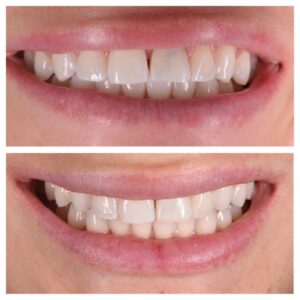Have you just chipped a permanent tooth? Do you have a single stained tooth that impacts the look of your smile? Ask us about dental bonding. Dr. Jomana Shayota offers teeth bonding in Franklin, MI to address minor tooth damage and blemishes. Dental bonding is a cosmetic dentistry treatment at Dental House and Aesthetics that offers quick and painless care with brilliant results.

What is Teeth Bonding?
Teeth bonding is a cosmetic dental procedure that Dr. Shayota uses to enhance the appearance of teeth. This minimally invasive cosmetic technique involves applying a tooth-colored resin material to the affected teeth. The purpose is to hide dental imperfections that affect the aesthetics of your smile. The dentist must shape it by hand and apply a special light to harden it.
Teeth bonding is commonly used to repair minor damage and tooth imperfections. Dr. Shayota will suggest tooth bonding to fix chipped or cracked teeth, close gaps, or change the shape and color of teeth.
The Benefits of Dental Bonding
If you have a damaged tooth, a single discolored tooth, or want to close a gap between your teeth, ask us about bonding treatment. Dr. Shayota will help determine if bonding is suitable for your specific needs. Choosing dental bonding treatment comes with many benefits. The advantages of a tooth bonding treatment include:
- Tooth protection: Dental bonding can help protect your teeth from further damage. If you have chips or cracks in your enamel, the bonding material acts like a shield. It adds a layer of strength for teeth that have lost part of their structure. This can prevent small issues from becoming bigger problems.
- Improved shape: Bonding is a great way to restore the shape of teeth that are chipped, cracked, or fractured. Our dentist can carefully apply the bonding material to fill in missing areas, making your tooth look whole again. It can also make slightly crooked teeth look straighter.
- Natural look: The resin used in dental bonding is tooth-colored and carefully matched to the shade of your natural teeth. Once polished, it blends in seamlessly and has a shine similar to healthy enamel. Most people won’t be able to tell which teeth were treated.
- Affordable solution: Compared to other cosmetic treatments like porcelain veneers or dental crowns, bonding is one of the most budget-friendly options. It’s an effective way to fix imperfections without a big investment.
- Quick results: One of the best parts of dental bonding is how fast it is. Most bonding procedures can be completed in a single dental visit. In many cases, you can walk out with a refreshed smile in a couple hours, depending on how many teeth are being treated.

Before and after teeth bonding from Dr. Jomana Shayota.
Teeth Bonding with Dr. Jomana Shayota
Dr. Shayota will begin the procedure by color-matching the bonding material to your natural teeth. The tooth preparation step, which involves gently roughening the tooth surface, is straightforward and non-invasive. This ensures the bonding material adheres properly to the tooth without the need for a local anesthetic.
Dr. Shayota will then apply the bonding material directly to the tooth. She will shape the material by hand to create the correct tooth shape. This step requires a high level of skill to recreate a tooth that looks natural.
After she applies the bonding material and shapes it to match your tooth, Dr. Shayota will use a high-intensity light to cure and harden the resin quickly. She’ll then make final adjustments, trimming off any excess material. The tooth is then cleaned and polished, leaving you with a natural-looking smile.
Am I A Candidate for Dental Bonding?
Tooth bonding works well for people who want to fix minor dental problems. This treatment can help if you have:
- Chipped or cracked teeth
- Small gaps between teeth
- Teeth with uneven shapes
- Stained or discolored teeth that whitening didn’t fix
Bonding is a good choice for people who want a simple, affordable way to improve their smile without extensive dental work. It’s less invasive than other treatments and usually only takes one visit. However, your teeth and gums need to be healthy before getting bonding. If you have serious tooth decay or gum disease, you must treat those problems first. Bonding won’t work well on damaged or unhealthy teeth.
During your visit, Dr. Shayota will check your teeth carefully. She’ll look at your oral health and discuss what you want to change about your smile. Then she can tell you if bonding is the best option for you or if another treatment would work better. Bonding isn’t right for everyone, but it’s often a great solution for small cosmetic changes. The results look natural and can last several years with proper care.
Patient Review
Alternatives to Teeth Bonding
If you want a longer-lasting or more permanent solution for improving your smile, we offer several alternatives to dental bonding. The right choice for you will depend on your dental health, cosmetic goals, and budget. Dr. Shayota will recommend the best options for you.
Veneers
Porcelain veneers are thin, custom-made covers that go over the front of your teeth. They last longer than bonding and resist stains better. Veneers look very natural and can fix problems like chips, gaps, or discoloration. Because they require removing a small amount of enamel, they are a permanent solution that provides beautiful, long-lasting results.
Dental Crowns
A crown might be the best choice if you have severe tooth damage or decay. Dental crowns cover the whole tooth, protecting weak teeth from breaking and restoring worn or damaged teeth. They come in materials like porcelain and metal.
Invisalign Clear Aligners
For crooked teeth or bite problems, Invisalign might be a better option than bonding. These clear plastic trays gradually straighten teeth and are nearly invisible. You can take them out when eating or brushing. Unlike bonding, which only covers imperfections, Invisalign actually fixes alignment issues for better long-term oral health.
Professional Teeth Whitening
If your main concern is stained teeth, whitening could be a simpler solution than bonding. Professional teeth whitening can lighten your teeth several shades. It works well for surface stains and costs less than bonding. We usually only recommend bonding for stains if whitening doesn’t work.
During your consultation, Dr. Shayota will discuss all of your cosmetic dentistry options. She’ll help you find the best treatment based on factors like the extent of damage, aesthetic goals, and budget.
Frequently Asked Questions
Do you want to learn more? We’re here to help. Read answers to common questions about tooth bonding in Franklin, MI.
Is teeth bonding an appropriate treatment for a child?
Dental bonding is an excellent solution for our younger patients. Children and teens with minor tooth damage or aesthetic issues can benefit from tooth bonding treatment. Compared to dental veneers and crowns, bonding is non-invasive and not permanent. This is especially helpful for those who still have significant oral development left to go.
The procedure is not painful or traumatic, and there is minimal tooth prep, making it perfect for younger patients who may be anxious at the dentist. As the child grows, they will require touch-up work or replacement bonding, or you can consider a more permanent option once oral development is complete.
Is bonding good for front teeth?
Yes, bonding works well for front teeth. It’s a great option to fix chips, cracks, gaps, or discoloration. The composite resin used in bonding blends well with your natural teeth, making it ideal for visible areas like the front. Plus, the procedure is quick and usually painless.
Can bonding fix gaps between teeth?
Dental bonding can fix small gaps between teeth. It’s a quick, affordable option. The dentist applies a tooth-colored resin to fill the gaps, shaping it to match your natural teeth. Bonding works best for minor gaps. Larger spaces might need other treatments like veneers or orthodontics. The results can last several years with good care.
Can bonding be done over existing fillings?
Bonding over existing fillings is possible, but it’s not always ideal. The success depends on the filling’s condition and location. Sometimes, removing the old filling first gives better results. Bonding adheres best to the natural tooth structure. We can assess the situation and recommend the best approach. We may also suggest replacing the filling entirely before bonding treatment.
How much tooth do I need for bonding?
Bonding requires enough healthy tooth structure to support the bonding material. Typically, a small to moderate amount of tooth is sufficient. Your dentist needs enough surface area to securely apply and shape the resin. If too much tooth structure is missing, we may recommend options like a veneer or crown. We’ll assess your tooth to determine if bonding is appropriate.
How long does bonding on a tooth last?
Bonding on a tooth typically lasts between 3 to 10 years. Its lifespan largely depends on factors like the location of the bonded tooth, your oral hygiene, and habits such as grinding teeth. You should avoid hard foods and continue to brush and floss to maintain your bonded teeth. Regular dental check-ups also ensure it stays in good condition.
Schedule a Dental Consultation for Teeth Bonding in Franklin, MI
Do you want to know more about dental bonding? Call Dental House and Aesthetics for treatment today at (248) 963-7925. You can also request a dental appointment with Dr. Shayota on our website. Let Dr. Shayota know if you have questions about bonding treatment. She’s here to help.
